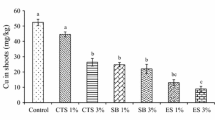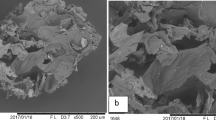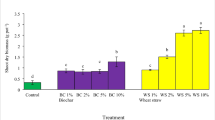Abstract
Plant uptake is a major pathway by which toxic metals can enter the food chain. In this laboratory study we grew spinach, radish, and perennial ryegrass on sand blends containing 50% waste foundry sand (WFS) to assess the availability of Al, B, Ba, Be, Cd, Co, Cr, Cu, Fe, Mg, Mn, Mo, Ni, Pb, V, and Zn. The WFSs utilized in this study were from aluminum, iron, and steel foundries. Although there were differences in the amounts of metals accumulated by the various plant species, excessive amounts of heavy metals were not taken up, regardless of WFS treatment. In spinach and radish, B, Cu, Fe, Mn and Zn were found to be within or close to the sufficiency range for agronomic crops. In ryegrass cuttings at 27, 57, and 87 days, Cu and Zn were within sufficiency ranges, but plants were Fe deficient and contained elevated concentrations of B, Mn, and Mo. Data from this study will be useful for state regulatory agencies interested in developing beneficial use regulations for WFSs.
Similar content being viewed by others
References
Amacher, M. C. (1996). Nickel, cadmium, and lead. In D. L. Sparks et al. (Eds.), Methods of soil analysis: Chemical methods, Part 3 (pp. 739–768). Soil Science Society of America Book Series no. 5. Madison, WI.
Antoniadis, V., & Alloway, B. J. (2001). Availability of Cd, Ni and Zn to ryegrass in sewage sludge-treated soils at different temperatures. Water, Air and Soil Pollution, 132, 201–214.
Banerjee, M. R., Burton, D. L., & Depoe, S. (1997). Impact of sewage sludge application on soil biological characteristics. Agricultural Ecosystems and Environment, 66, 241–249.
Basta, N. T., Ryan, J. A., & Chaney, R. L. (2005). Trace element chemistry in residual-treated soil: Key concepts and metal bioavailability. Journal of Environmental Quality, 34, 49–63.
Brown, S. L., Chaney, R. L., Lloyd, C. A., Angle, J. S., & Ryan, J. A. (1996). Relative uptake of cadmium by garden vegetables and fruits grown on long-term biosolid-amended soils. Environmental Science & Technology, 30, 3508–3511.
Carey, P. (2002). Sand/binders/sand preparation/mold & coremaking. Foundry Management & Technology, 130, 39–52.
Chaney, R. L. (1983). Potential effects of waste constituents on the food chain. In J. F. Parr, P. B. Marsh & J. M. Kla (Eds.), Land treatment of hazardous wastes (pp. 152–240). Park Ridge, NJ: Noyes Data Corp.
Chaney, R. L., & Codling, E. E. (2005). Bio-based plant nutrient products: Heavy metals considerations. Proceedings Workshop Bio-Based Plant Nutrient Products. In R. Reynelles (Ed.), Bio-based nutrient products: Quality assurance, marketing and regulations (pp. 22–36). Seattle, WA.
Chaney, R. L., & Giordano, P. M. (1977). Microelements as related to plant deficiencies and toxicities. In L. F. Elliott & F. J. Stevenson (Eds.), Soils for management of organic wastes and waste waters (pp. 234–279). Madison, WI: ASA.
Chunilall, V., Kindness, A., & Jonnalagadda, S. B. (2004). Heavy metal uptake by spinach leaves grown on contaminated soils with lead, mercury, cadmium, and nickel. Journal of Environmental Science and Health, B39, 473–481.
Davies, B. E. (1993). Radish as an indicator plant for derelict land: Uptake of zinc at toxic concentrations. Communications in Soil Science and Plant Analysis, 24, 1883–1895.
Davies, B. E., & Houghton, N. J. (1984). The use of radish as a monitor crop in heavy metal polluted soils. In Proceedings of international conference of the United Nations Environmental Program (IRPTC)-Environmental Contamination, London, UK, CEP Consultants Ltd, Edinburgh, pp. 327–332.
Davies, B. E., & Lear, J. M. (1984). Heavy metal uptake by radish in relation to soil fertility and chemical extractability of metals. Tasks for Vegetation Science, 13, 307–312.
Hooda, P. S., McNulty, D., Alloway, B. J., & Aitken, M. N. (1997). Plant availability of heavy metals in soils previously amended with heavy applications of sewage sludge. Journal of the Science of Food and Agriculture, 73, 446–454.
Jing, J., & Barnes, S. (1993). Agricultural use of industrial by-products. BioCycle, 63–64. (November)
Jones Jr, J. B., Wolf, B., & Mills, H. A. (1991). Plant analysis handbook: A practical sampling, preparation, analysis, and interpretation guide. Athens, GA: Micro-Macro.
Kabata-Pendias, A., & Pendias, H. (1992). Trace elements in soils and plants (2nd Ed.). Boca Raton, FL: CRC.
Korcak, R. F., & Fanning, D. S. (1978). Extractability of cadmium, copper, nickel, and zinc by double acid versus DTPA and plant content at excessive soil levels. Journal of Environmental Quality, 7, 506–512.
Kukier, U., Peters, C. A., Chaney, R. L., Angle, J. S., & Roseberg, R. J. (2004). The effect of pH on metal accumulation in two Alyssum species. Journal of Environmental Quality, 33, 2090–2102.
Lindsay, B. J., & Logan, T. J. (2005). Agricultural reuse of foundry sand. J. Resid. Sci. Technol., 2, 3–12.
Lindsay, W. L., & Norvell, W. A. (1978). Development of a DTPA soil test for zinc, iron, manganese, and copper. Soil Science Society of America Journal, 42, 421–428.
Mills, H. A., & Jones Jr, J. B. (1996). Plant analysis handbook II: A practical sampling, preparation, analysis, and interpretation guide. Athens, GA: Micro-Macro.
National Research Council (1980). Mineral tolerance of domestic animals (p. 577). Washington, D.C.: National Academy of Sciences.
Novozamsky, I., Lexmond, T. M., & Houba, V. J. G. (1993). A single extraction procedure of soil for evaluation of uptake of some heavy metals by plants. International Journal of Environmental Analytical Chemistry, 51, 47–58.
Pascual, I., Antolín, M. C., García, C., Polo, A., & Sánchez-Díaz, M. (2004). Plant availability of heavy metals in a soil amended with a high dose of sewage sludge under drought conditions. Biology and Fertility of Soils, 40, 291–299.
Power, J. F., & Dick, W. A. (2000). Land application of agricultural, industrial, and municipal by-products. Soil Science Society of America Book Series no. 6. Madison, WI.
Quevauviller, P. (1998). Operationally defined extraction procedures for soil and sediment analysis I. Standardization. Trends in Analytical Chemistry, 17, 289–298.
Shacklette, H. T., & Boerngen, J. G. (1984). Element concentrations in soils and other surficial materials of the conterminous United States. U.S. Geol. Surv. Prof. Paper. 1270 (105 pp.). Washington, DC: US. Gov. Printing Office.
Sukkariyah, B. F., Evanylo, G., Zelazny, L., & Chaney, R. L. (2005). Cadmium, copper, nickel, and zinc availability in a biosolids-amended piedmont soil years after application. Journal of Environmental Quality, 34, 2255–2262.
Tyler, G., & Olsson, T. (2001). Plant uptake of major and minor mineral elements as influenced by soil acidity and liming. Plant and Soil, 230, 307–321.
U.S. EPA. Test methods for evaluating solid wastes, physical/chemical methods, SW-846 On-line; http://www.epa.gov/epaoswer/hazwaste/test/main.htm.
U.S. EPA (2002). Beneficial reuse of foundry sand: A review of state practices and regulations. Washington, DC.: Sectors Strategies Division, Office of Policy, Economics, and Innovation.
Acknowledgements
The authors would like to thank Dr. Carrie Green for conducting the ICP-AES analyses.
Author information
Authors and Affiliations
Corresponding author
Rights and permissions
About this article
Cite this article
Dungan, R.S., Dees, N.H. Use of Spinach, Radish, and Perennial Ryegrass to Assess the Availability of Metals in Waste Foundry Sands. Water Air Soil Pollut 183, 213–223 (2007). https://doi.org/10.1007/s11270-007-9370-8
Received:
Accepted:
Published:
Issue Date:
DOI: https://doi.org/10.1007/s11270-007-9370-8




